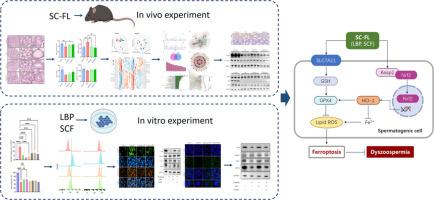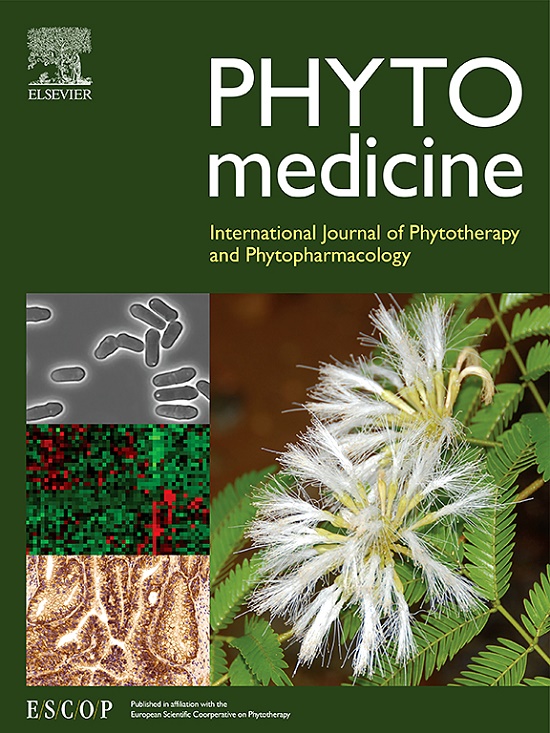Semen Cuscutae-Fructus Lycii attenuates tripterygium glycosides-induced spermatogenesis dysfunction by inhibiting oxidative stress-mediated ferroptosis via the Nrf2/HO-1 pathway
IF 6.7
1区 医学
Q1 CHEMISTRY, MEDICINAL
引用次数: 0
Abstract
Background
Semen Cuscutae and Fructus Lycii (SC-FL) is known for its potential therapeutic effects on spermatogenesis dysfunction. However, the underlying mechanisms of SC-FL in alleviating spermatogenesis dysfunction is still being elucidated.
Purpose
This study aimed to explore the effects of SC-FL on spermatogenesis dysfunction and investigate the involved mechanisms, specifically focusing on the modulation of oxidative stress and ferroptosis.
Methods
A mouse model of spermatogenesis dysfunction was induced by tripterygium glycosides, followed by treatment with SC-FL. Assessment of testicular spermatogenic function in the mice was performed alongside lipidomics analysis to investigate the metabolic mechanisms of SC-FL. The effects on oxidative stress and ferroptosis-related markers were evaluated, the chemical constituents of SC-FL were identified using liquid chromatography-mass spectrometry, and network pharmacology analysis was carried out. Additionally, an in vitro model of spermatogenesis dysfunction was established using triptolide-induced GC-1 cells, which were treated with Lycium barbarum polysaccharides (LBP) and flavonoids from Semen Cuscutae (FSC) to explore their impact on cell damage, oxidative stress-mediated damage, and ferroptosis.
Results
SC-FL improved the mouse model of spermatogenesis dysfunction by inhibiting oxidative stress-mediated ferroptosis. In vitro experiments demonstrated that LBP and FSC relieved GC-1 cell damage, with their mechanisms also associated with the inhibition of oxidative stress-mediated ferroptosis.
Conclusion
SC-FL alleviates spermatogenesis dysfunction in animal and cell models, potentially through the modulation of the Nrf2/HO-1 signaling pathway, which consequently inhibits oxidative stress-mediated ferroptosis in spermatogonial cells.

菟丝子-枸杞通过Nrf2/HO-1途径抑制氧化应激介导的铁蛋白沉积,从而减轻三叶皂甙诱导的精子发生功能障碍
背景菟丝子和枸杞子(Semen Cuscutae and Fructus Lycii,SC-FL)因其对生精功能障碍的潜在治疗作用而闻名。本研究旨在探讨SC-FL对精子发生功能障碍的影响,并研究其相关机制,尤其侧重于对氧化应激和铁蛋白沉积的调节。方法用三叶皂甙诱导精子发生功能障碍小鼠模型,然后用SC-FL治疗。在评估小鼠睾丸生精功能的同时,还进行了脂质组学分析,以研究 SC-FL 的代谢机制。评估了对氧化应激和铁变态反应相关指标的影响,使用液相色谱-质谱法鉴定了 SC-FL 的化学成分,并进行了网络药理学分析。此外,还利用三苯氧胺诱导的 GC-1 细胞建立了精子发生功能障碍的体外模型,并用枸杞多糖(LBP)和菟丝子黄酮(FSC)处理该模型,以探讨它们对细胞损伤、氧化应激介导的损伤和铁蛋白沉积的影响。体外实验表明,枸杞多糖和 FSC 能缓解 GC-1 细胞损伤,其机制也与抑制氧化应激介导的铁绒毛膜促性腺激素有关。结论SC-FL 能缓解动物和细胞模型中的生精功能障碍,可能是通过调节 Nrf2/HO-1 信号通路,从而抑制精原细胞中氧化应激介导的铁绒毛膜促性腺激素。
本文章由计算机程序翻译,如有差异,请以英文原文为准。
求助全文
约1分钟内获得全文
求助全文
来源期刊

Phytomedicine
医学-药学
CiteScore
10.30
自引率
5.10%
发文量
670
审稿时长
91 days
期刊介绍:
Phytomedicine is a therapy-oriented journal that publishes innovative studies on the efficacy, safety, quality, and mechanisms of action of specified plant extracts, phytopharmaceuticals, and their isolated constituents. This includes clinical, pharmacological, pharmacokinetic, and toxicological studies of herbal medicinal products, preparations, and purified compounds with defined and consistent quality, ensuring reproducible pharmacological activity. Founded in 1994, Phytomedicine aims to focus and stimulate research in this field and establish internationally accepted scientific standards for pharmacological studies, proof of clinical efficacy, and safety of phytomedicines.
 求助内容:
求助内容: 应助结果提醒方式:
应助结果提醒方式:


